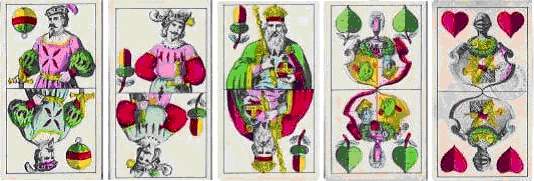|
About its origin there is still a mystery. It was made in Ulm, Bamberg (but with different patterns on Daus) and later in Darmstadt. The first decks appeared as single figure cards around 1820. Double figure cards are known since 1860. They disappeared after the World War I. around 1925.
The figures of Ober and Unter wear clothing in style of renaissance and remind of mercenary cards. Important characteristics are the Daus pattern and the fact that both halves of cards are colored different.
The Daus shows symbols of the student life or contemporary pleasure (acorns), symbols of arts and sciences (leaves), symbols of military or war (hearts) and agriculture or trade (bells).
The name for this pattern was given because the deck in L2, 103. Therefore it found the entrance in the literature so. Today it is clear: the roots of this pattern are in Ulm (L8, X).
 |
|
 |
| L3, 70 (Joseph Arnold, around 1833) |
|
L2, 103 (Frommann & Morian, appr. 1880) |
The pip cards of single figure decks show little scenes of rural life and area, well known also from other German playing cards. These scenes are missing at double figures cards.
 |
|
 |
| L3, 70 (Joseph Arnold, around 1833) |
|
L2, 103 (Frommann & Morian, appr. 1880) |

L4, 98 (Georg Panzer, Bamberg, 1843-1849)
|

L7, 500 / L8, XII (Christoph Scheiffele, Ulm, approx. 1850 / 1865)
|

L1, 116 (unknown, around 1860)
|
 |
|
 |
| L9, Nr.9 (unknown, around 1860) |
|
L9, Nr. 10 (unknown, around 1870) |
The drawings of the follow two decks are very similar. Some details are to find on both.

L9, Nr.9 (unknown, around 1860)
|

L6, Nr. 5 (Deuce of Bells: JEL [Jegel, Nuremberg?], 1860)
|


An old variant of double figure deck of an unknown manufacturer out of
Stralsund, but it seems that is the successor of L1, 116.
Some different examples and patchwork

L5, 166 (Xaver Arnold, Neuburg a.D., around1880)
|

UK coll. (Frommann & Morian, Darmstadt around 1905)
|

internet (Frommann & Morian, Darmstadt around 1920)
|

UK coll. (VSS, Stralsund, without indices, around 1905)
|

UK coll. (VSS, Stralsund, with indices, around 1925)
|
L1, 116 (unknown, South Germany? around 1860)
L2, 103 (Frommann & Morian, Darmstadt, appr. 1880)
L3, 70 (Joseph Arnold, Neuburg a.D., around 1833)
L3, 71 (Johann Conrad Jegel, Nürnberg, around 1860)
L4, 98 (Georg Panzer, Bamberg, between 1843-1849)
L5, 166 (Xaver Arnold, Neuburg a.D., around1880)
L7, 500 (Christoph Scheiffele, Ulm, appr. 1850)
UK coll. (Different decks, collection Ulrich Knüpfer)
Literature:
| L1: |
Alle Karten auf den Tisch
Sylvia Mann, 1990
Band 1 - Text
Band 2 - Bild |
| L2: |
Bube, Dame, König
Alte Spielkarten aus Berliner Museums - u. Privatsammlungen
Kohlmann, Radau, Schlede, 1982 |
| L3: |
Deutsche Spielkarten 1650-1900.
Katalog der Spielkarten mit deutschen Farben
Germanisches
Museum Nürnberg.
Sigmar Radau, Gerd Matthes, 2001 |
| L4: |
Geschichte auf Spielkarten 1789 - 1871
Deutsches Spielkarten-Museum, Leinfelden-Echterdingen,
Hoffmann, Detlef & Margot Dietrich, 1987 |
| L5: |
Spielkartenangebot XXIX
MGM Joker KG, 2003 |
| L6: |
Expositions Espace Tajan, Cartes À Jouer Du XVIII. Au XX. Siècle
Marie-Sarah Villeroy De Galhau, Thierry Depaulis, 2004 |
| L7: |
Zusammenstellung von Spielkarten seit 1850
Franz Braun, 1970 |
| L8: |
Spielkartenangebot XXVII
MGM Joker KG, 2001 |
| L9: |
Alte Spielkarten
Klaus-Jürgen Schultz, Frieder Büchler, 2005 |
|



